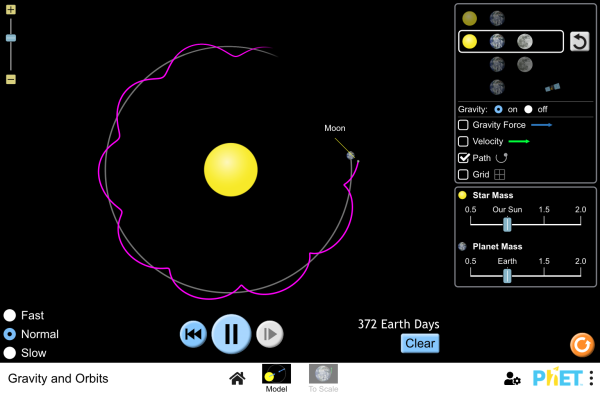In the vast frictionless environment of space, gravitational attraction can cause two massive bodies to orbit each other.
If the relative velocity between two bodies is too low they will collide. If the velocity is too high they will move away from each other. In between these extremes exist a range of stable orbits that can repeat with almost no change.
Yet, over time orbits degrade. The Moon's orbit gets 38 mm farther away every year because its kinetic energy changes into tidal friction.
Circular Motion
Any object moving in a circular path has a net force pointed at the center of the circle. The velocity of the object will always be perpendicular to the force.
$$F = \frac{mv^{2}}{r} \quad \quad a = \frac{v^{2}}{r} $$
\(F\) = centripetal force [N]
vector
\(a\) = centripetal acceleration [m/s²]
vector
\(v\) = tangential velocity [m/s]
vector
\(r\) = radius of the circular path [m]
vector
\(m\) = mass [kg]
The term centripetal means pointing at the center. In all circular motion force and acceleration always points at the center of the circle. This is often confused with centrifugal, which means away from the center.
Tangential means touching at only one point. Since the velocity is perpendicular to the centripetal force, it doesn't enter or exit the circle.
Nearly circular motion can occur in many situations:
solution
$$F = \frac{mv^{2}}{r}$$ $$F = \frac{(20)(3)^{2}}{5}$$ $$F = 36\,\mathrm{N}$$ $$\text{towards the center of the carousel}$$answer
Yes, the ball is accelerating towards the center of the circle.
It's possible to produce an acceleration similar to gravity without a gravitational field. It's done by rotating a room to produce a centripetal acceleration.
Example: You are designing a rotating spaceship with artificial gravity. In your plans, the ship is shaped like a wheel with a diameter of 50.0 m. How fast does the outer edge have to move to produce a centripetal acceleration equal to the gravity felt on Earth's surface?solution
$$d = 2r \quad \quad r = 25\,\mathrm{m}$$ $$a = \frac{v^{2}}{r}$$ $$\sqrt{ar} = v$$ $$\sqrt{(9.8)(25)} = v$$ $$15.7 \,\mathrm{\tfrac{m}{s}} =v$$Example: Use the circumference of a circle and the tangential velocity of the ship to calculate how long one rotation will take.
hint
$$C = 2 \pi r$$ $$v=\frac{\Delta x}{\Delta t}$$ $$v=\frac{2 \pi r}{\Delta t}$$solution
Your 50 meter spaceship design was built. It produced the illusion of 9.8 m/s² of gravity, but people are complaining they feel strange when standing up.
Example: Use the circumference of a circle at a person's head and the time for one rotation to calculate the velocity at the top of a 2 meter tall person's head.strategy
A person on the rotating spaceship will have their feet on the outer edge, and their heads pointed towards the center. This means the head will have a shorter radius and a slower speed.
$$d = 2r \quad d = 50 \, \mathrm{m}$$ $$r = 25-2 = 23\, \mathrm{m}$$We also know that the total time for one rotation must be the same at any distance from the center. We calculated the time for one rotation in the previous example.
solution
We already calculated that one rotation takes 10 seconds.
$$d = 2r \quad d = 50 \, \mathrm{m}$$ $$r = 25-2 = 23\, \mathrm{m}$$$$v=\frac{\Delta x}{\Delta t} \quad C = 2 \pi r$$ $$v=\frac{2 \pi r}{\Delta t}$$ $$v=\frac{2 \pi (23)}{(10)}$$ $$v=14.45\, \mathrm{\tfrac{m}{s}}$$
Example: What acceleration would a 2 meter tall person feel at their head? Compare that to the acceleration felt at their feet.
solution
$$a = \frac{v^{2}}{r}$$ $$a = \frac{14.45^{2}}{23}$$ $$a = 9.07\,\mathrm{\tfrac{m}{s^2}}$$$$\frac{9.07}{9.8} = 0.92$$
A person's head only feels 92% of the gravity at their feet.
Question: What changes could be made to the spaceship design to reduce the difference in acceleration between a person's head and feet?
answer
The ship's radius could be increased, but that would increase the costs.
The ship could produce a lower acceleration, maybe half of Earth's gravity.
Circular Orbits
Each satellite below starts with a different velocity. Simulation speed =
The orbits of bodies in space are elliptical. They are never perfectly circular, but many orbits come close enough to circular motion to make a rough approximation useful.
derivation of orbital velocity
If we assume that the central mass is much larger and doesn't move, we can combine the equations for circular motion with the universal gravitation equations.
$$F = \frac{M_{1}v^{2}}{r} \quad F = \frac{GM_{1}M_{2}}{r^{2}} $$ $$\frac{M_{1}v^{2}}{r} = \frac{GM_{1}M_{2}}{r^{2}} $$ $$\frac{ {\color{blue}M_{1} }v^{2}}{\color{blue}r} = \frac{G{\color{blue}M_1} M_{2}}{{\color{blue}r}^2}$$ $$v^{2} = \frac{GM_{2}}{r} $$$$v^{2} = \frac{GM}{r} $$
\(v\) = orbital tangential velocity [m/s]
\(G\) = 6.67408 × 10-11 = universal gravitation constant [N m²/kg²]
\(r\) = radius of the circular orbit [m]
\(M\) = mass of the central body being orbited [kg]
The orbiting body needs to be much smaller than the central body!
Only true for circular orbits!
Situations where there is circular motion and a much larger central body include: planets orbiting the Sun, moons orbiting large planets, and satellites.
Example: If a satellite is 800.0 km above the surface of the moon how fast must it move to travel in a circular orbit?
solution
$$r = 800\,000\,\mathrm{m} + 1\,737\,000\,\mathrm{m} = 2\,537\,000\,\mathrm{m}$$ $$v^{2} = \frac{GM}{r}$$ $$v^{2} = \frac{(6.67 \times 10^{-11})(7.346 \times 10^{22})}{2\,537\,000}$$ $$\sqrt{v^{2}} = \sqrt{19.31 \times 10^5}$$ $$v = 1389.6 \,\mathrm{\tfrac{m}{s}}$$answer
They both have the same velocity. The mass of the satellite doesn't matter, only the mass of the Earth.
Radius Vs. Orbital Velocity
(for satellites in circular motion around Earth)
solution
$$v^{2} = \frac{GM}{r}$$ $$r = \frac{GM}{v^{2}}$$ $$r = \frac{(6.67 \times 10^{-11})(5.972 \times 10^{24})}{(3070)^{2}}$$ $$r = 4.22 \times 10^{7} \,\mathrm{m} = 42\,200 \,\mathrm{km}$$$$\text{altitude = orbital radius - Earth's surface radius}$$ $$\text{altitude} = 42\,200 \,\mathrm{km} - 6371 \,\mathrm{km}$$ $$\text{altitude} = 35\,829 \,\mathrm{km}$$
You can get a feeling for orbits with this PhET gravitational orbit simulation.
What happens to the path of a satellite when you turn off gravity?
How would you describe the direction of the velocity compared to the force?
How does the orbital path change as you increase the mass of either object?
